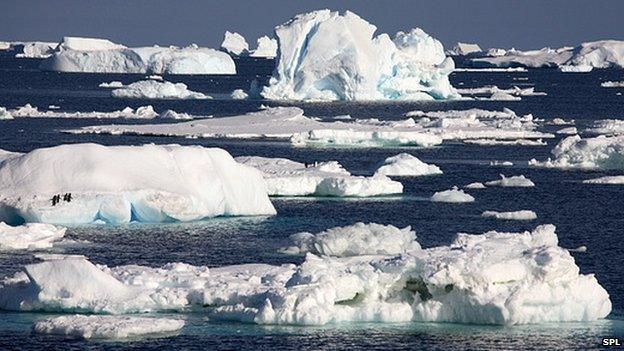Melt may explain Antarctica's sea ice expansion
- Published

Antarctic sea ice shows a small but significant expansion, in contrast to the trend seen in the Arctic
Climate change is expanding Antarctica's sea ice, according to a scientific study in the journal Nature Geoscience.
The paradoxical phenomenon is thought to be caused by relatively cold plumes of fresh water derived from melting beneath the Antarctic ice shelves.
This melt water has a relatively low density, so it accumulates in the top layer of the ocean.
The cool surface waters then re-freeze more easily during Autumn and Winter.
This explains the observed peak in sea ice during these seasons, a team from the Royal Netherlands Meteorological Institute (KNMI) in De Bilt says in its peer-reviewed paper, external.
Climate scientists have been intrigued by observations that Antarctic sea ice shows a small but statistically significant expansion of about 1.9% per decade since 1985, while sea ice in the Arctic has been shrinking, external over past decades.
The researchers from the KNMI suggest the "negative feedback" effect outlined in their study is expected to continue into the future.
They tried to reproduce the observed changes in a computer-based climate model.
The sea ice expanded during Southern Hemisphere autumn and winter in response to the development of a fresh, cool surface water layer, which floated on the denser, warmer salty sea water below.
This fresh water is ultimately derived from enhanced melting at the base of the Antarctic ice shelves.
"Sea ice around Antarctica is increasing despite the warming global climate," said the study's lead author Richard Bintanja, from the KNMI.
"This is caused by melting of the ice sheets from below," he told the Reuters news agency.
But there are other plausible explanations for Antarctic sea-ice expansion.
Paul Holland of the British Antarctic Survey (BAS) stuck to his findings last year that a shift in winds linked to climate change was blowing ice away from the coast, allowing exposed water in some areas to freeze and make yet more ice.
"The possibility remains that the real increase is the sum of wind-driven and melt water-driven effects, of course. That would be my best guess, with the melt water effect being the smaller of the two," he told the London Science Media Centre.
The study in Nature Geoscience also asserts that the cool melt water layer may limit the amount of water sucked from the oceans that falls as snow on Antarctica. Cold air can hold less moisture than warm air.
- Published8 March 2013
- Published13 February 2013
- Published19 September 2012
- Published21 August 2012